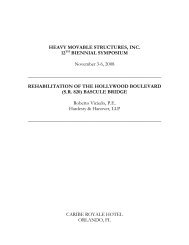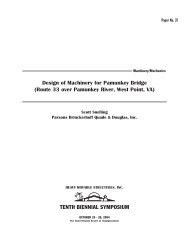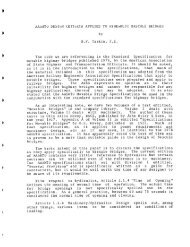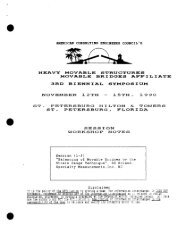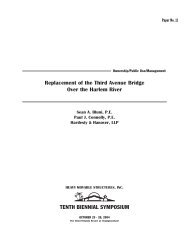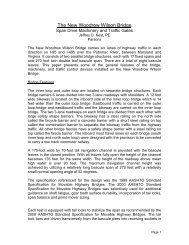Hydraulic Slewing Drives for the Coleman Swing Span Bridge
Hydraulic Slewing Drives for the Coleman Swing Span Bridge
Hydraulic Slewing Drives for the Coleman Swing Span Bridge
You also want an ePaper? Increase the reach of your titles
YUMPU automatically turns print PDFs into web optimized ePapers that Google loves.
HYDRAULIC CIRCUIT<br />
(Continued)<br />
Pressured Compensated - A pressure control valve whose primary function is<br />
to permit a pump to operate at minimum load. It is integral to <strong>the</strong> open circuit<br />
pump. Controlled by system pressure, displacement of <strong>the</strong> pump decreases as<br />
pressure increases, so that <strong>the</strong> pump output at <strong>the</strong> preset pressure is only<br />
sufficient to make up <strong>for</strong> leakage.<br />
Proportional Directional Control Valve - Typically a valve whose function is<br />
to direct flow through selected passages according to electronic reference<br />
signals. They operate in association with electronic driver cards which supply <strong>the</strong><br />
proportional valves with <strong>the</strong> correct current signal to modulate valve spool<br />
position to <strong>the</strong> referenced signal, in this application a t 10 volt DC signal. The<br />
electro hydraulic proportional control valves per<strong>for</strong>m both directional and speed<br />
control functions, through <strong>the</strong>ir ability to position infinitely an internal valve<br />
element to create an infinitely - variable orifice. This variable orifice throttles fluid<br />
flow to control load speed. Directional control of <strong>the</strong> hydraulic motor is<br />
accomplished much like that of a conventional solenoid - operated three position,<br />
four way valve.<br />
<strong>Hydraulic</strong> Counterbalancing - A counterbalance valve installed in <strong>the</strong> outgoing<br />
fluid line to keep <strong>the</strong> load (swing span) from getting ahead of <strong>the</strong> fluid supply.<br />
The valve is piloted from <strong>the</strong> upstream or pressure side of <strong>the</strong> motor.<br />
The use of a counterbalance valve provides a back pressure on <strong>the</strong> motor outlet,<br />
when needed, to prevent <strong>the</strong> load from <strong>for</strong>cing <strong>the</strong> motor to over-run <strong>the</strong> oil<br />
supply, <strong>the</strong>reby keeping <strong>the</strong> moving span, in a controlled state. During normal<br />
operation, when <strong>the</strong> hydraulic motor is driving <strong>the</strong> span, <strong>the</strong> pilot signal derived<br />
from <strong>the</strong> pressure side of <strong>the</strong> motor pilots <strong>the</strong> valve open and removes all back<br />
pressure from <strong>the</strong> motor outlet. During periods of deceleration, inlet pressure to<br />
<strong>the</strong> motor drops to zero and <strong>the</strong> counter balance valve is <strong>the</strong>n piloted open by<br />
back pressure from <strong>the</strong> motor outlet.<br />
Page 7





